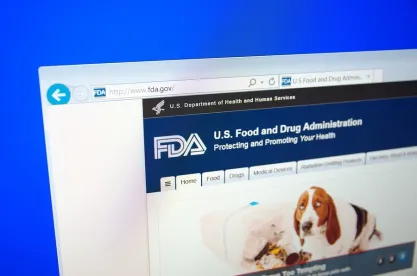Summary
This article reviews the US Food and Drug Administration’s recently released draft guidance on promotional materials and communications that are consistent with FDA-required labeling. The guidance provides a three-factor test for determining if communications about information not contained in the FDA-required labeling are consistent with FDA-required labeling; explains what evidentiary support companies must include in their communications so that they are not false or misleading; and provides recommendations on how to develop communications that would comply with the draft guidance so as not to mislead the recipients of the communications. Though the draft guidance provides many examples of communications that would meet its recommendations, FDA encourages firms to seek a legal, regulatory and medical review by qualified personnel before disseminating such communications.
In Depth
In the waning days of the Obama administration, the US Food and Drug Administration (FDA) released a draft guidance on promotional materials entitled Medical Product Communications that are Consistent with the FDA-Required Labeling – Questions and Answers. The guidance is narrowly tailored and limited to communications about approved or cleared uses of a drug, biological product or device that are consistent with, but are not included in, FDA-required labeling. The agency defines “FDA-required labeling” as either: labeling that FDA has reviewed and approved or, if a product is not subject to premarket approval, labeling that provides adequate directions for use and other information required to appear in the labeling. As a result, the guidance does not address the types of off-label communications discussed in Amarin Pharma, Inc. v. US FDA— truthful and non-misleading promotion of an approved or cleared medical product for an unapproved use.
The guidance explains how manufacturers, packers, distributors and their representatives may communicate information in promotional materials and data about approved or cleared uses that are not included in FDA-required labeling. The guidance sets forth a three-factor test that FDA will use to determine if a drug, biological product or device firm is communicating information about its product consistent with FDA-required labeling. The factors are summarized as follows:
-
Does the communication provide information that differs from, or is in conflict with, the information about the conditions of use in the FDA-required labeling (i.e., a different indication or patient population or conflicting handling directions, dosage or strength)?
-
Will the information in the communication increase the potential for harm to health, when compared to the information in the FDA-required labeling?
-
Do the directions for use in the FDA-required labeling enable the product to be safely and effectively used under the conditions discussed in the communication?
The agency will apply the three-factor test to evaluate express and implied claims in product communications and make a fact-specific determination as to whether a communication is consistent with FDA-required labeling.
The guidance emphasizes that communicating information in a manner consistent with the FDA-required labeling is not enough to avoid enforcement action. Firms also must ensure their communications do not provide false or misleading information that would misbrand the product. For example, a true statement may be misleading if the communication as a whole omits material facts or obscures relevant contextual information regarding the statement. FDA will review communications to determine if they provide “scientifically appropriate and statistically sound” evidentiary support for any representations or suggestions in the communication. Firms must reveal material facts and risk information in such communications, base representations on facts and science, and provide appropriate context. FDA notes, however, that the agency will not determine that a communication is false or misleading based solely on the communication’s failure to provide information that would meet FDA’s evidentiary standards for clearance or approval, since the agency has already approved or cleared the product based on evidence provided in the premarket review or device classification process.
The guidance clarifies that if a communication with information not included in FDA-required labeling is consistent with FDA-required labeling, the agency will not rely on the communication alone as evidence of a new intended use. FDA indirectly regulates the content of communications through the agency’s intended use regulations. For example, FDA may examine a tweet, press release or statement made by, or on behalf of a manufacturer to determine the intended use of a product. The guidance also states that a communication that is consistent with FDA-required labeling will not be viewed as failing to comply with the statutory requirement that the product’s labeling contain adequate directions for use.
FDA recommends that firms have qualified legal, medical and regulatory personnel review their promotional materials prior to dissemination. The guidance also provides three recommendations on how firms may develop non-misleading communications that are consistent with FDA-required labeling:
-
Communications should accurately depict study results, data and information (i.e., disclose material aspects of study design, methodology and material limitations related to the design, methodology and results).
-
The communication should disclose unfavorable or inconsistent findings, so relevant information is presented in context and accurately characterized.
-
The communication should include data from the FDA-required labeling, if the FDA-required labeling is related to the data discussed in the communication, so as to provide appropriate context.
The guidance is notable for the types of promotional communications it did not address. FDA declined to tackle off-label communications regarding information that is not consistent with FDA-required labeling, such as the treatment of a different disease or different strengths, dosages, or routes of administration. Firms interested in making such communications should refer to existing draft and final guidance documents on off-label promotion and risk information: FDA’s draft guidance on responding to unsolicited requests for off-label information about prescription drugs and medical devices; the agency’s final guidance on good reprint practices for disseminating publications on unapproved new uses of approved or cleared products; and a draft guidance on distributing publications on risk information for approved drugs and biological products.
Drug, biological product and device manufacturers, packers, distributors and their representatives should consider submitting comments on the draft guidance by the date listed in the Federal Register notice of availability announcing the guidance—April 19, 2017.





 />i
/>i

